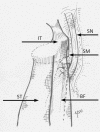Expert opinion: diagnosis and treatment of proximal hamstring tendinopathy
- PMID: 25878983
- PMCID: PMC4396672
Expert opinion: diagnosis and treatment of proximal hamstring tendinopathy
Abstract
Background: proximal hamstring tendinopathy (PHT) is a disabilitating disease often causing underperformance in the athletically demanding patients. The main symptom of PHT is lower gluteal pain especially during running or while prolonged sitting. Mainly affecting athletically active individuals, PHT is a considerable challenge for treating health care professionals.
Purpose: this paper aims to concisely present the literature on PHT to guide health care professionals treating these patients and doing research on the subject.
Methods: we reviewed the literature on PHT through literature search of scientific journal databases.
Conclusions: as a tendinopathic pathology, it is a rather recently discovered exertion injury. As with other chronic tendon overuse injuries, current treatment strategies are unspecific with uncertain outcomes due to the unknown etiology of the tendon degeneration. Diagnostic features as well as both operative and non-operative treatments are evaluated from a clinical perspective, providing up to date information for clinicians and sports medicine therapists dealing with hamstring problems.
Level of evidence: V.
Keywords: exertion injury; hamstring; tendinopathy; treatment.
Figures




Similar articles
-
Treatment of Proximal Hamstring Tendinopathy with Individualized Physiotherapy: A Clinical Commentary.Int J Sports Phys Ther. 2025 Jun 2;20(6):892-910. doi: 10.26603/001c.138308. eCollection 2025. Int J Sports Phys Ther. 2025. PMID: 40469642 Free PMC article.
-
Proximal Hamstring Tendinopathy: Clinical Aspects of Assessment and Management.J Orthop Sports Phys Ther. 2016 Jun;46(6):483-93. doi: 10.2519/jospt.2016.5986. Epub 2016 Apr 15. J Orthop Sports Phys Ther. 2016. PMID: 27084841 Review.
-
Rehabilitation and Prevention of Proximal Hamstring Tendinopathy.Curr Sports Med Rep. 2017 May/Jun;16(3):162-171. doi: 10.1249/JSR.0000000000000355. Curr Sports Med Rep. 2017. PMID: 28498225 Review.
-
Magnetic Resonance Imaging With a Novel Hip Flexion Scanning Position for Diagnosing Proximal Hamstring Tendinopathy.Orthop J Sports Med. 2024 Sep 25;12(9):23259671241265130. doi: 10.1177/23259671241265130. eCollection 2024 Sep. Orthop J Sports Med. 2024. PMID: 39328883 Free PMC article.
-
Proximal hamstring tendinopathy; expert physiotherapists' perspectives on diagnosis, management and prevention.Phys Ther Sport. 2021 Mar;48:67-75. doi: 10.1016/j.ptsp.2020.12.008. Epub 2020 Dec 18. Phys Ther Sport. 2021. PMID: 33378733
Cited by
-
Soft tissue pseudotumours: a pictorial review with emphasis on MRI.Muscles Ligaments Tendons J. 2017 Sep 18;7(2):353-375. doi: 10.11138/mltj/2017.7.2.353. eCollection 2017 Apr-Jun. Muscles Ligaments Tendons J. 2017. PMID: 29264349 Free PMC article. Review.
-
Current and future advances in practice: tendinopathies of the hip.Rheumatol Adv Pract. 2024 Apr 10;8(2):rkae022. doi: 10.1093/rap/rkae022. eCollection 2024. Rheumatol Adv Pract. 2024. PMID: 38601140 Free PMC article. Review.
-
Posterior, Lateral, and Anterior Hip Pain Due to Musculoskeletal Origin: A Narrative Literature Review of History, Physical Examination, and Diagnostic Imaging.J Chiropr Med. 2016 Dec;15(4):281-293. doi: 10.1016/j.jcm.2016.08.004. Epub 2016 Oct 21. J Chiropr Med. 2016. PMID: 27857636 Free PMC article. Review.
-
Tears of biceps femoris, semimembranosus, and semitendinosus are not equal-a new individual muscle-tendon concept in athletes.Scand J Surg. 2021 Dec;110(4):483-491. doi: 10.1177/1457496920984274. Epub 2021 Feb 21. Scand J Surg. 2021. PMID: 33612019 Free PMC article. Review.
-
A systematic review of surgical intervention in the treatment of hamstring tendon ruptures: current evidence on the impact on patient outcomes.Ann Med. 2022 Dec;54(1):978-988. doi: 10.1080/07853890.2022.2059560. Ann Med. 2022. PMID: 35416097 Free PMC article.
References
-
- Lempainen L, Banke IJ, Johansson K, Brucker PU, Sarimo J, Orava S, et al. Clinical principles in the management of hamstring injuries. Knee Surg Sports Traumatol Arthrosc. 2014 - PubMed
-
- Maffulli N, Khan KM, Puddu G. Overuse tendon conditions: time to change a confusing terminology. Arthroscopy. 1998;14(8):840–843. - PubMed
-
- Lempainen L, Sarimo J, Mattila K, Vaittinen S, Orava S. Proximal hamstring tendinopathy: results of surgical management and histopathologic findings. Am J Sports Med. 2009;37(4):727–734. - PubMed
-
- Roels J, Martens M, Mulier JC, Burssens A. Patellar tendinitis (jumper’s knee) Am J Sports Med. 1978;6(6):362–368. - PubMed
Publication types
LinkOut - more resources
Full Text Sources
Research Materials
